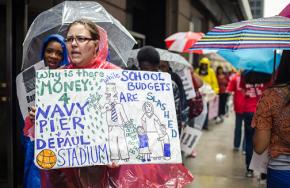For fighting teachers’ unions
As rank-and-file teachers around the U.S. seek to revitalize their unions, looks at the high stakes in the struggles ahead.
THE SCHOOL year is set to begin with teachers looking to the example of last year's successful Chicago Teachers Union (CTU) strike as their union locals face their toughest struggles in 50 years.
It's difficult to overstate the challenges facing public school teachers--and the children, parents and communities they serve--as the next wave of corporate-driven "education reform" takes shape.
Privatization is rampant, with chunks of entire school systems like New Orleans and Detroit being turned over to charter operators--or with plans to turn them over. Half of the schools in Kansas City, Mo., have already been closed. In Los Angeles, charter schools have siphoned some 10 percent of student enrollment away from traditional public schools. In Philadelphia, budget cuts are being used to threaten the layoff of thousands of teachers unless their union agrees to staggering contract concessions.
What's more, new legislation in states across the U.S. mandate harsh evaluation schemes, attacks on teacher tenure and the proliferation of charters, thanks to the Obama administration's federal Race to the Top grant program that requires such changes.

The CTU strike was far and away the biggest and most successful example of teacher resistance to this onslaught. At a time when the CTU's national affiliate, the American Federation of Teachers (AFT), is in full retreat, the Chicago teachers showed that an active, determined rank-and-file, in close alliance with parents and community allies, could take on the politically powerful Mayor Rahm Emanuel--and win.
The contract did include some concessions--including reduced compensation for laid-off teachers and an intrusive "wellness" health care program in exchange for a freeze in employee-paid health insurance costs. But Emanuel completely failed to achieve his main goals of establishing higher merit pay, harsher teacher evaluation schemes and fast-track firings of teachers rated as weak. The CTU also won contract language to help strengthen the union at school sites.
The struggle in Chicago continues, of course. Some 49 elementary schools are set to close while budget cuts are costing teacher jobs and setting the stage for a massive increase in class sizes. But an energized CTU continues to fight back alongside its allies--a direct result of a strike that hinged on a continuous mass mobilization and democratic decision-making.
The CTU contract could--and should--have become a model for other locals of the AFT and the much larger National Education Association (NEA). In fact, teacher union locals such as the Berkeley Federation of Teachers have hosted CTU speakers to help gear up for contract campaigns.
But AFT President Randi Weingarten, by contrast, has continued her strategy of surrendering key elements of teacher unionism like tenure and opposition to merit pay in order to preserve a one-sided "partnership" with school districts and politicians. Weingarten played a direct role in finalizing such a deal in Cleveland, which was also tied to state legislation that will funnel tax money to charter schools.
Weingarten was personally involved in the negotiation of the Newark Teachers Union (NTU) contract that was negotiated in the wake of the CTU strike. The AFT president greeted the approval of the deal in a television appearance with New Jersey Gov. Chris Christie, the Republican who built a national profile with his attacks on his state's teachers’ unions.
The Newark contract, underwritten with $100 million from Facebook billionaire Mark Zuckerberg, ties pay raises to performance and offers as much as $12,000 in merit pay to "high performing" teachers in hard-to-staff schools and subject areas. It also clears the way for the dismissal of low-performing teachers based on the state's new law on teacher evaluations. The New York Times editorial board was quick to contrast Newark teachers with their Chicago counterparts, having earlier denounced the strike as "Chicago teachers' folly."
AFTER EXPERIENCING their new contract, however, Newark teachers opted for the Chicago model instead. Reformers in the NEW caucus nearly toppled the incumbent president of the NTU, and won a majority of the union's executive board.
The reformers' success in Newark came just a few weeks after their counterparts in New York had an unexpectedly strong showing in elections in the United Federation of Teachers (UFT), the largest and dominant local of the AFT. The Movement of Rank and File Educators (MORE) managed to win 40 percent of the votes of high school teachers, albeit in a record low turnout. Inspired by the Chicago experience, MORE was created by a merger of several other currents in a bid to boost activism and fight for democracy in a bureaucratic local that's adrift after going years without a contract.
The impact of CORE can be seen in other cities, too. Teacher union militants got another recent boost in Washington, D.C., where reformer-turned-bureaucrat Nathan Saunders was was ousted as president of the Washington Teachers Union (WTU).
A similar dynamic is unfolding in United Teachers Los Angeles, where a two-term reform leadership failed to halt the decline in wages and compensation, opening the way for the current union president, Warren Fletcher, to win office on a platform of being a more professional and effective negotiator. But Fletcher's inability or unwillingness to stand up to a series of attacks on the union has spurred a revived UTLA reform network to initiate successful membership referendum on preparing for a strike. A reform challenge to Fletcher is likely in next year's union elections.
CERTAINLY, OUSTING ineffective or conservative leaders is an important goal of militants among teachers, as it is for other union activists. And as the Chicago experience shows, a fighting union leadership can make a critical difference. But for most teachers union locals, those are long-term goals. So what do they do now?
That's where CORE's history is key. While the caucus only came into existence a couple of years before taking office, its roots go back decades to previous CTU reform movements. More recently, many CORE members were part of the reform administration of Deborah Lynch from 2001-2004, which was ousted after negotiating a weak contract. Others were active in the fight against the militarization of schools as well as school closures. Many first met in organizing around issues of violence that claimed their students.
As CTU President Karen Lewis often points out, CORE wasn't formed with the idea of taking over the union, but simply making it more effective. The first step was understanding the enemy: hence a study group around Naomi Klein's book, The Shock Doctrine. CORE's first big public meeting in January 2009 drew 500 people in the midst of a classic Chicago blizzard, compelling the then-union president to show up to speak.
Long before it took office--before that was even conceivable to most of its activists--CORE succeeded in shifting the debate in the union on a critical issue. That meant putting the issue of racism at the forefront of the fight against school closures and charter schools.
The success of that meeting--and the removal of some schools from the closure list--wasn't sufficient to catapult CORE into office 17 months later, however. It was the split in the union's old guard that opened the way for an untested group of militants to take over the second-biggest union in the AFT. It took another two years of intensive work to mobilize the membership for a strike--a task made easier by Rahm Emanuel's constant insults and provocations, such as cancelling a contractual 4 percent raise.
Certainly there's much to be learned by trade unionists everywhere in studying CORE's activist orientation and organizational savvy. But what makes CORE different is the politics behind the operation. While it is far from a politically homogenous group--CORE unites everyone from Democrats to socialists--the role of the left has been crucial. Socialists, radicals and militants from various organizations and political currents work together in CORE to emphasize union democracy, rank-and-file activism and militant action. This comes not from a nostalgia from labor's better days, but from a sober recognition of the prospects for unions in an era of a depressed economy, a rollback of the public sector and rampant social inequality.
Just as important, CORE militants saw from the beginning that the teachers' struggle had to be the same as that of students and parents. Thus, there was no difference between the CTU's message to its members during the strike and to the wider community: Chicago teachers were defending public education, and got overwhelming support as a result.
CORE's argument can be summed up as this: Teachers' unions will have to struggle harder than they have for decades simply to hold on to what they have--and their fight must be part of a wider working-class movement to defend public services and a decent standard of living. If the revival of teacher reform groups is any indication, it's a message that teachers are ready to hear.


